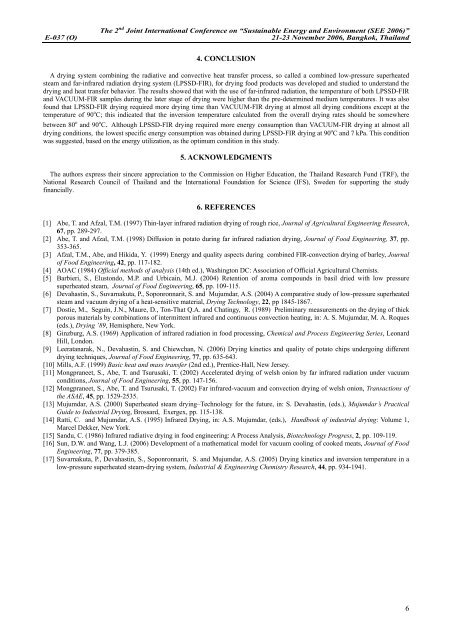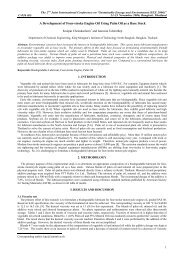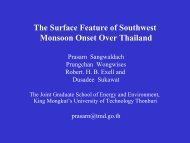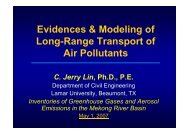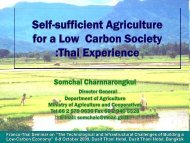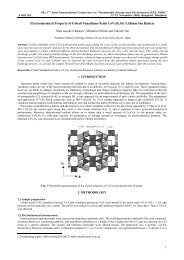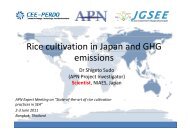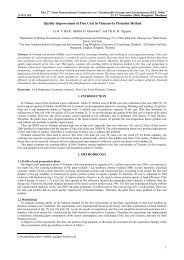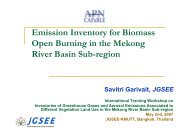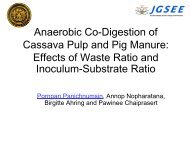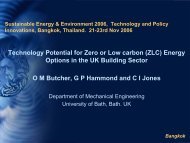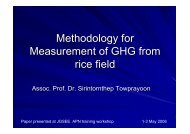Drying and Heat Transfer Behavior of Combined Low ... - JGSEE
Drying and Heat Transfer Behavior of Combined Low ... - JGSEE
Drying and Heat Transfer Behavior of Combined Low ... - JGSEE
- No tags were found...
You also want an ePaper? Increase the reach of your titles
YUMPU automatically turns print PDFs into web optimized ePapers that Google loves.
The 2 nd Joint International Conference on “Sustainable Energy <strong>and</strong> Environment (SEE 2006)”E-037 (O) 21-23 November 2006, Bangkok, Thail<strong>and</strong>4. CONCLUSIONA drying system combining the radiative <strong>and</strong> convective heat transfer process, so called a combined low-pressure superheatedsteam <strong>and</strong> far-infrared radiation drying system (LPSSD-FIR), for drying food products was developed <strong>and</strong> studied to underst<strong>and</strong> thedrying <strong>and</strong> heat transfer behavior. The results showed that with the use <strong>of</strong> far-infrared radiation, the temperature <strong>of</strong> both LPSSD-FIR<strong>and</strong> VACUUM-FIR samples during the later stage <strong>of</strong> drying were higher than the pre-determined medium temperatures. It was als<strong>of</strong>ound that LPSSD-FIR drying required more drying time than VACUUM-FIR drying at almost all drying conditions except at thetemperature <strong>of</strong> 90 o C; this indicated that the inversion temperature calculated from the overall drying rates should be somewherebetween 80 o <strong>and</strong> 90 o C. Although LPSSD-FIR drying required more energy consumption than VACUUM-FIR drying at almost alldrying conditions, the lowest specific energy consumption was obtained during LPSSD-FIR drying at 90 o C <strong>and</strong> 7 kPa. This conditionwas suggested, based on the energy utilization, as the optimum condition in this study.5. ACKNOWLEDGMENTSThe authors express their sincere appreciation to the Commission on Higher Education, the Thail<strong>and</strong> Research Fund (TRF), theNational Research Council <strong>of</strong> Thail<strong>and</strong> <strong>and</strong> the International Foundation for Science (IFS), Sweden for supporting the studyfinancially.6. REFERENCES[1] Abe, T. <strong>and</strong> Afzal, T.M. (1997) Thin-layer infrared radiation drying <strong>of</strong> rough rice, Journal <strong>of</strong> Agricultural Engineering Research,67, pp. 289-297.[2] Abe, T. <strong>and</strong> Afzal, T.M. (1998) Diffusion in potato during far infrared radiation drying, Journal <strong>of</strong> Food Engineering, 37, pp.353-365.[3] Afzal, T.M., Abe, <strong>and</strong> Hikida, Y. (1999) Energy <strong>and</strong> quality aspects during combined FIR-convection drying <strong>of</strong> barley, Journal<strong>of</strong> Food Engineering, 42, pp. 117-182.[4] AOAC (1984) Official methods <strong>of</strong> analysis (14th ed.), Washington DC: Association <strong>of</strong> Official Agricultural Chemists.[5] Barbieri, S., Elustondo, M.P. <strong>and</strong> Urbicain, M.J. (2004) Retention <strong>of</strong> aroma compounds in basil dried with low pressuresuperheated steam, Journal <strong>of</strong> Food Engineering, 65, pp. 109-115.[6] Devahastin, S., Suvarnakuta, P., Soponronnarit, S. <strong>and</strong> Mujumdar, A.S. (2004) A comparative study <strong>of</strong> low-pressure superheatedsteam <strong>and</strong> vacuum drying <strong>of</strong> a heat-sensitive material, <strong>Drying</strong> Technology, 22, pp 1845-1867.[7] Dostie, M., Seguin, J.N., Maure, D., Ton-That Q.A. <strong>and</strong> Chatingy, R. (1989) Preliminary measurements on the drying <strong>of</strong> thickporous materials by combinations <strong>of</strong> intermittent infrared <strong>and</strong> continuous convection heating, in: A. S. Mujumdar, M. A. Roques(eds.), <strong>Drying</strong> ’89, Hemisphere, New York.[8] Ginzburg, A.S. (1969) Application <strong>of</strong> infrared radiation in food processing, Chemical <strong>and</strong> Process Engineering Series, LeonardHill, London.[9] Leeratanarak, N., Devahastin, S. <strong>and</strong> Chiewchan, N. (2006) <strong>Drying</strong> kinetics <strong>and</strong> quality <strong>of</strong> potato chips undergoing differentdrying techniques, Journal <strong>of</strong> Food Engineering, 77, pp. 635-643.[10] Mills, A.F. (1999) Basic heat <strong>and</strong> mass transfer (2nd ed.), Prentice-Hall, New Jersey.[11] Mongpraneet, S., Abe, T. <strong>and</strong> Tsurusaki, T. (2002) Accelerated drying <strong>of</strong> welsh onion by far infrared radiation under vacuumconditions, Journal <strong>of</strong> Food Engineering, 55, pp. 147-156.[12] Mongpraneet, S., Abe, T. <strong>and</strong> Tsurusaki, T. (2002) Far infrared-vacuum <strong>and</strong> convection drying <strong>of</strong> welsh onion, Transactions <strong>of</strong>the ASAE, 45, pp. 1529-2535.[13] Mujumdar, A.S. (2000) Superheated steam drying–Technology for the future, in: S. Devahastin, (eds.), Mujumdar’s PracticalGuide to Industrial <strong>Drying</strong>, Brossard, Exergex, pp. 115-138.[14] Ratti, C. <strong>and</strong> Mujumdar, A.S. (1995) Infrared <strong>Drying</strong>, in: A.S. Mujumdar, (eds.), H<strong>and</strong>book <strong>of</strong> industrial drying: Volume 1,Marcel Dekker, New York.[15] S<strong>and</strong>u, C. (1986) Infrared radiative drying in food engineering: A Process Analysis, Biotechnology Progress, 2, pp. 109-119.[16] Sun, D.W. <strong>and</strong> Wang, L.J. (2006) Development <strong>of</strong> a mathematical model for vacuum cooling <strong>of</strong> cooked meats, Journal <strong>of</strong> FoodEngineering, 77, pp. 379-385.[17] Suvarnakuta, P., Devahastin, S., Soponronnarit, S. <strong>and</strong> Mujumdar, A.S. (2005) <strong>Drying</strong> kinetics <strong>and</strong> inversion temperature in alow-pressure superheated steam-drying system, Industrial & Engineering Chemistry Research, 44, pp. 934-1941.6


